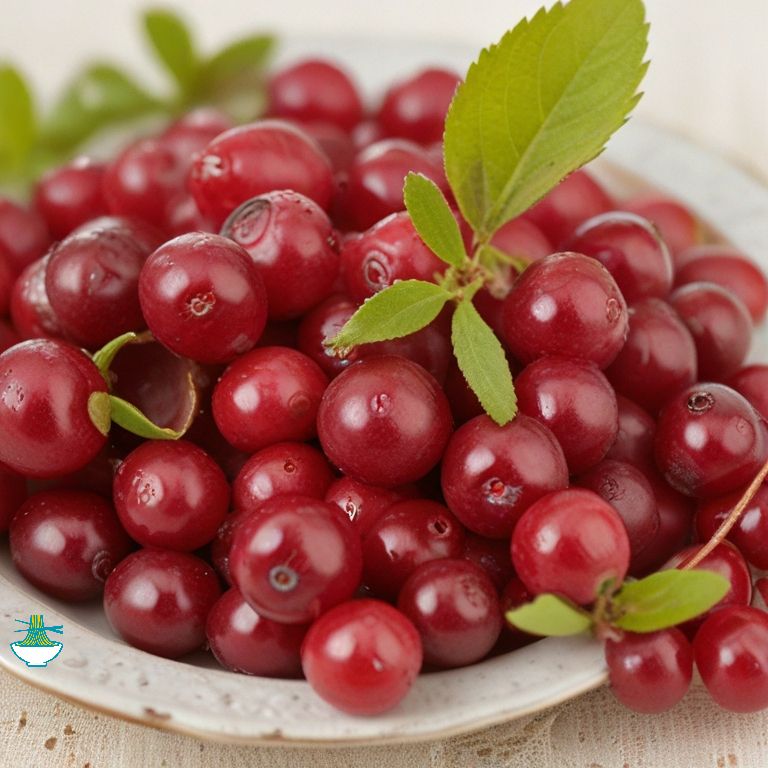Indulge in the exquisite taste of the Greenland Lingonberry, a rare gem of the Arctic wilderness. Bursting with tartness and sweetness in perfect harmony, these crimson jewels thrive in the harsh polar conditions, developing a unique flavor profile unlike any other. Handpicked by skilled foragers amidst breathtaking landscapes, Greenland Lingonberries offer a taste of untamed nature in every bite. Elevate your culinary creations with their vibrant presence or savor them as a delightful snack, and experience the essence of the Arctic encapsulated in this exceptional fruit.
Ingredients:
- 2 cups fresh Greenland Lingonberries
- 1/2 cup water
- 1/2 cup granulated sugar (adjust to taste)
- 1 tablespoon lemon juice
- Optional: 1 cinnamon stick or a pinch of ground cinnamon for added flavor

Instructions:
1- Rinse the Greenland Lingonberries thoroughly under cold water and remove any stems or debris.
2- In a saucepan, combine the lingonberries, water, sugar, and lemon juice. If using a cinnamon stick, add it to the mixture.
3- Bring the mixture to a gentle boil over medium heat, then reduce the heat to low and let it simmer for about 10-15 minutes, stirring occasionally.
4- As the lingonberries cook, they will start to burst and release their juices. Use the back of a spoon to lightly crush some of the berries, helping to thicken the sauce.
5- Taste the sauce and adjust the sweetness by adding more sugar if desired. If using ground cinnamon instead of a cinnamon stick, add it now and stir well.
6- Continue simmering the sauce for another 5-10 minutes until it reaches your desired consistency. It should be thick enough to coat the back of a spoon.
7- Once the sauce has thickened, remove it from the heat and let it cool slightly.
8- Transfer the lingonberry sauce to a clean jar or container and let it cool completely before storing it in the refrigerator.
9- Serve the lingonberry sauce as a topping for desserts like cheesecake or ice cream, or use it as a flavorful accompaniment to savory dishes like roasted meats or poultry.
Enjoy the tangy sweetness of this Greenland Lingonberry sauce, adding a burst of Arctic flavor to your favorite recipes!
Nutritional Values:
here are the approximate nutritional values for the ingredients commonly used in lingonberry recipes:
Greenland Lingonberries: Nutritional information for Greenland Lingonberries may vary, but generally, lingonberries are rich in vitamins C and K, dietary fiber, and antioxidants. Per 100g serving of raw lingonberries:
- Calories: 43 kcal
- Carbohydrates: 9.6g
- Fiber: 3.3g
- Sugars: 4.5g
- Vitamin C: 29.8mg (50% DV)
- Vitamin K: 8.1µg (10% DV)
Water:
Water contains no calories, fats, proteins, or carbohydrates.
benefits:Water is essential for hydration and helps regulate body temperature. It supports various bodily functions, including digestion, nutrient absorption, and waste removal
Granulated Sugar: Per 1 teaspoon (4g) of granulated sugar:
- Calories: 16 kcal
- Carbohydrates: 4g
- Sugars: 4g
benefits:While granulated sugar provides quick energy due to its carbohydrate content, it should be consumed in moderation. Excessive sugar intake may lead to weight gain and other health issues. However, in small amounts, sugar can enhance the flavor of dishes
Lemon Juice: Per 1 tablespoon (15ml) of lemon juice:
- Calories: 4 kcal
- Carbohydrates: 1.3g
- Sugars: 0.5g
- Vitamin C: 9% of the Daily Value (DV)
benefits:Lemon juice is a good source of vitamin C, an antioxidant that supports immune function, collagen production for healthy skin, and iron absorption. It also adds a tangy flavor to recipes.
Cinnamon Stick/Ground Cinnamon: Cinnamon is often used in small amounts, and its nutritional contribution is minimal. Per 1 teaspoon (2.6g) of ground cinnamon:
- Calories: 6 kcal
- Carbohydrates: 2.1g
- Fiber: 1.4g
- Calcium: 26.1mg (3% DV)
- Iron: 0.2mg (1% DV)
benefits:Cinnamon contains antioxidants and anti-inflammatory properties. It may help regulate blood sugar levels, improve heart health, and lower cholesterol. Additionally, cinnamon adds warmth and depth to dishes without adding calories or sodium.
Keep in mind that these values are approximate and can vary based on factors such as the variety of lingonberries and specific brands of ingredients used.


Comments